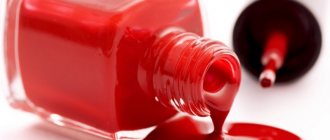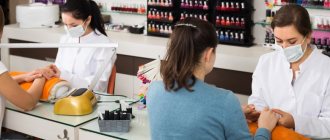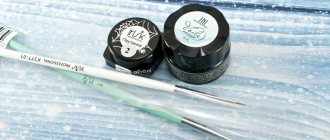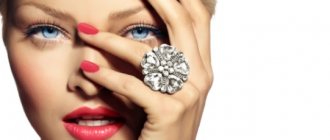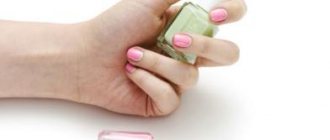Gel nail polish is harmful if it contains formaldehyde, toluene, or dibutyl phthalate. Damage to the health of nails can be caused by poor drying, over-wearing of the coating, performing a manicure with fungus, with damage to the cuticle and matrix. The result may be their breaking off, delamination, thinning, pain, dryness of the plates and skin.
Onycholysis and Pseudomonas aeruginosa may appear. You can also cause harm by incorrectly removing gel polish if you damage the cuticle and germ layer of the plates. This causes tuberosity, inflammation, and external defects.
Gel polish will not cause harm if you use high-quality products, do not violate the technology of applying and removing it, and take breaks from wearing the coating for 3-3.5 months. The safest ones are Kodi, Ingarden, IBD, Irisk, OPI, IQ Beauty.
Is gel nail polish harmful due to its composition: myths and reality
The composition of gel nail polish is not harmful if it contains only the following substances:
- Pigments. They can be made from natural ingredients. But even if their origin is purely chemical, there is no need to be afraid.
- Photoinitiator. This is the component that absorbs light radiation from the lamp. Thanks to it, the coating dries. And it does not have a negative effect on the body.
- Film former. A component that gives the coating hardness, but also maintains elasticity. The film former prevents it from cracking and pulling on growing nails.
- Solvents. This can be ethyl acetate, isopropyl alcohol, butyl acetate and other components that maintain the liquid consistency of the composition.
- Stabilizers. The substances give the gel polish thickness. The group includes trimethylolpropane, the mineral bentonite, and silicon dioxide. They also do not affect health.
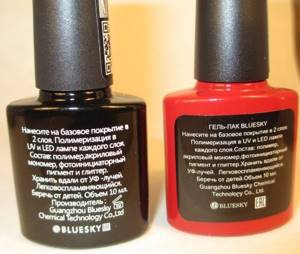
But the opinion about the negative impact of coating on nails and the body as a whole is by no means a myth if the gel polish contains:
- Formaldehyde. This is a known preservative, but it is also a toxic component and tends to accumulate. The substance can reduce immunity, cause allergies, and have a bad effect on the respiratory system. The effect does not weaken as long as formaldehyde is on the nails.
- Toluene. This is also a solvent with a pungent odor, resulting from oil refining, and has a cumulative effect. Its negative effect is mainly on the kidneys, liver and muscle fibers. The substance can also damage your nails.
- Dibutyl phthalate. Another toxic solvent that can interfere with the functioning of the endocrine and reproductive systems.

Fortunately, not all gel polishes contain these components. Newly emerging products do without them, which does not prevent them from being bright and remaining on the nails for a long time.
What does it consist of?
There are hundreds of brands offering nail coatings on the shelves of online and offline stores. In most cases, the composition of these products is identical and includes the same components.
The most common ingredients in gel polish include:
- Monomers. Hidden on the label under the combinations of Hydroxypropyl Acrylate and Hydroxyethyl Methacrylate. Monomers are used to harden the coating when exposed to ultraviolet rays;
- Photoinitiator - Hydroxycyclohexyl phenyl ketone. Absorbs ultraviolet rays and starts the polymerization process. Depending on the manufacturer, the amount of photoinitiator varies, which affects the speed of solidification;
- Pigment is a substance that provides a color coating. The composition is marked with an abbreviation, for example CI 8965;
- Solvents. Used to facilitate polymerization that occurs when entering into a chemical bond with monomers;
- Fragrances. To give the product an unobtrusive aroma of fruits or flowers.
The listed components are the basis of the gel polish, which allows it to create a dense coating on the nails with an increased wear time. In addition to the basic components, the composition also contains auxiliary ones - they are the ones that pose a health hazard.
What components of gel polishes and other coatings should be avoided:
- Formaldehyde, Formaldehyde. The most dangerous component that has been discussed from the first day of its addition to the varnish. Formaldehyde is a preservative that promotes long-term storage of the product and prevents the growth of bacteria. The component is allowed for use in nail polishes, but it is prohibited for contact with skin. Formaldehyde often causes allergies to gel polish coating. Manufacturers often hide the presence of formaldehyde in the composition and use non-standard names on the label - Aldehyd mravenc, Bfv, Methanal. Despite the danger, formaldehyde is actively used by manufacturers. Only in the USA a restriction has been introduced allowing the use of no more than 11% of it in the composition;
- Formaldehyde resin. May lead to skin inflammation and dermatitis.
- Toluene, Toluene is a substance from the group of solvents. Also referred to on the label as methylbenzene, methylbenzene, methane. Toluene is a toxic component, the vapors of which in high concentrations cause disorientation. Naturally, varnishes use a minimal amount of the substance, but even this is enough to cause irritation or an allergic reaction. Prohibited for use in all countries within the European Union;
- Dibutyl Phthalate, DBP - a component that protects the coating from cracking. It allows the gel polish to plasticize. Dibutyl phthalate has a negative effect on women's health, hormonal levels and provokes problems with reproductive function. In Europe, the component is prohibited for use in cosmetics;
- Methylisothiazolinone is a preservative that increases the shelf life of the product. Even in small quantities, the component disrupts the functioning of the central nervous system and also negatively affects brain function;
- Camphor, Camphor - used to add gloss. It is a relatively safe component, but with prolonged use it causes allergies. Inhalation of camphor provokes headache and nausea;
- Xylene, Xylene, is another component from the group of solvents that often causes allergic reactions. In addition, xylene may cause side effects such as dizziness, nausea and vomiting;
- Triphenyl phosphate is a plasticizer. It tends to be absorbed through the cuticle and accumulate in the body. Affects the hormonal system. Research by American scientists has proven that triphenyl phosphate has a negative effect on the endocrine system;
- Parabens are sulfate preservatives that mimic estrogen production. Studies have shown that exposure to parabens can trigger the development of breast tumors;
- Ethyl tosylamide. May cause severe allergic reactions, destruction of liver cells;
- Acetone, Acetone - when inhaled, can cause inflammation and sore throat.
Harm of gel nail polish: how it really affects nails, pros and cons of application
Harm from gel nail polish may occur if:
- cheap and low-quality products were used;
- the coating is thick;
- an old lamp is used, or the layer is dried for too long;
- manicure is done excessively often and without breaks;
- When removing the coating, the nail plates and skin are damaged.
In all these cases, gel polish has a negative effect on nails:
- they can flake, turn yellow, become thin and dry, and break;
- sometimes painful sensations occur;
- grooves, dents, spots form on the surface;
- the skin dries, peeling and hangnails appear on it;
- in severe cases, skin cancer and melanoma may occur.
But if you weigh the pros and cons, gel polish coating is no more dangerous than regular varnishes and, of course, more practical. It will last for a longer time, the manicure looks neat and expensive, helps to grow its own length and strengthen weak nails.
Is there any benefit
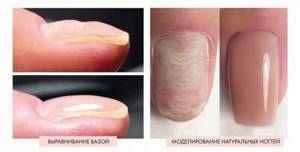
The benefits of gel polish coating are contained in many aspects:
- It looks luxurious. Conventional varnishes and topcoats do not provide the same shine or matte effect as those containing gel components. Products for “long-lasting” coating are more varied in shades and other effects.
- It lasts 3-4 weeks. Manicure saves time; you can forget about filing or tinting your nails for the entire period. And this, in turn, protects them from additional mechanical stress. Conventional varnishes wear off much earlier; they have to be washed off with solvents and a new layer applied, which is not beneficial.
- You can grow long nails if you had problems with this before. Gel polish involves the use of several layers of products that prevent the plate from breaking off if there is a crack. They are also protected from moisture and household chemicals.
- You can fix a broken nail and correct external defects. This will not work with ordinary varnishes; dents and bumps will still remain noticeable.
In addition, the manicure procedure itself has a positive effect on the nervous system. A woman feels well-groomed, feels that she is devoting time only to herself, and this is also relaxation. And there is an element of creativity in it.
Consequences due to drying
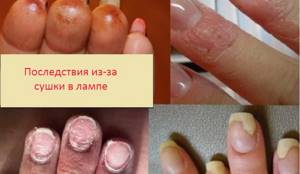
Negative consequences from a professional manicure may arise due to the use of a lamp to dry the coating:
- The appearance of problems such as thinning of the plates, increased fragility, and dehydration of the skin. This is caused by overdrying of tissues and evaporation of nutrients from them. Nails peel or begin to crumble. And peeling and hyperpigmentation may occur on the skin.
- Ultraviolet radiation can damage the epidermis, upper and germ layers of the nails. Burns and soreness in the area of the fingertips may occur. After all, even LED devices that are positioned as absolutely safe contain harmful radiation. And the more powerful the device, the more there is.
- Both previous problems can cause onycholysis. This is the separation of the nail plate from the bed. It occurs as a reaction to constant traumatization by light radiation and overheating of tissues.
- The lamp increases the risk of skin cancer and melanoma. It has been proven that if you are exposed to radiation frequently and without interruption, changes occur in tissues at the cellular level.
However, some scientists refute the last statement. And they say that even if you renew the coating weekly, a high-quality lamp will not harm your nails and skin.
What are the dangers when removing the coating?
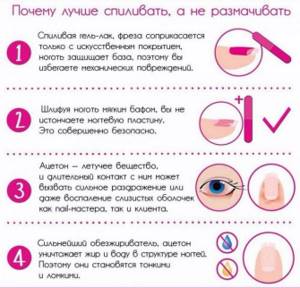
It may not be the gel polish that is dangerous, but its removal:
- Inept cutting of the coating with a milling cutter or hand tool is sometimes accompanied by damage to the nails. If it is superficial, it will just leave a dent. But with a deep wound, the defect may persist as the plate grows.
- Soaking with remover can also negatively affect their condition. After all, the liquid contains acetone, it dries out the nails and irritates the skin. The epidermis may appear red, blistering, itching,
Is gel coating harmful during pregnancy?
During pregnancy, gel nail coating can be harmful if it causes discomfort when performing a manicure, applying and drying nail polish. It is also undesirable to breathe dust and fumes from compounds in this state. Another important reason for refusing manicures with gel polishes is the higher likelihood of intolerance due to decreased immunity during pregnancy.
But it is not prohibited to apply the coating if you are feeling normal and have no allergies; it is only important to adhere to the following conditions:
- use products without toxic components (labeled 5free);
- perform the procedure in a ventilated area;
- before putting your hand into the lamp, use cream or wear gloves with open fingertips;
- Do not wear gel polish all the time, alternate it with regular or strengthening nail polish.
True, in pregnant women sometimes any covering quickly falls off. The reason for this is changed hormonal levels and increased hand humidity. And the condition of the nails may worsen, they become thinner and break. This occurs due to a lack of vitamins, because the body directs all resources to nourish the fetus. Therefore, pregnancy is a reason to take a break from applying gel polish, at least at the beginning and end of the period.
Watch the video about the reasons to refuse gel polish during pregnancy:
Is it possible to do this manicure during pregnancy?
The interesting position of a woman becomes the reason for increased sensitivity to most external influences that have at least some impact not only on themselves, but also on the growing baby.
- Of course, pregnant women cannot be refused and, if they wish, the use of shellac is allowed. But this must be done taking into account all, even minor rules, as well as with special caution and literacy.
- Before the procedure itself, it is necessary to apply a high-quality sunscreen to your hands, with an optimal SPF level of at least 30. It will significantly reduce the harmful effects of ultraviolet radiation.
- In no case should there be any toxic components in the composition of the varnishes used. All bottles must have the inscription “5 free”.
- It is better to alternate gel-based varnishes with simple enamels. But, ideally, it would be good to just leave your nails to rest.
- The process itself must be carried out in the fresh air, or in a well-ventilated room. This will significantly reduce the entry of harmful vapors into the body of a pregnant woman.
- In general, in this position you do not need to constantly wear a gel or even a regular coating. Of course, all women at any age and position want to look attractive and well-groomed. But due to hormonal changes, the nail plates already become dull and brittle, and you will also overload them with chemicals.
- Yes, sometimes this will help, on the contrary, to make your nails stronger while wearing the polish. But our advice is to use strengthening products to maintain your nails.

Does gel polish ruin your nails?
Gel polish spoils your nails if:
- Perform hygienic manicure too carefully. A well-processed cuticle looks attractive, but deep penetration of a cutter or pusher under the skin can cause injury to the matrix. Nails will begin to grow wavy or with permanent cracks. And this is a favorable environment for infections to enter and inflammation to begin. A fungal disease, panaritium, may occur.
- Re-wear the coating, that is, do not go for correction 3 weeks after the manicure. In this case, the load on the regrown edge of the nail increases. As a result, blood circulation in this area is disrupted and the matrix weakens. And onycholysis may occur. And it is especially undesirable to over-stretch for a long length, since the plates can break “into meat”.
- Apply thick layers of polymerizing agents each time. This requires prolonged drying in a lamp, as a result of which the tissue overheats. This is manifested by a burning sensation. And then the nails may become lumpy or, on the contrary, thin out and begin to peel off from the bed.
- Use unsuitable materials. For each type of nail, you need to choose the right base and top coat. Soft ones need a product like strong or other types of strengthening. Applying a rubber base will increase their mobility, that is, increase the risk of breakage and delamination. If the nails are quite strong and hard, they need a softer base. A product marked strong will tighten the plates, which can cause them to crack and break.
- Use low quality products. As a rule, they contain the harmful components mentioned earlier. They dry out the nails and corrode the top layer. As a result, the plates become lumpy, change color, fade, flake and break.
Reviews
Olga, 28 years old: “I’ve been wearing gel coating for a very long time; I haven’t taken it off at all for a couple of years. Maybe 3 or even 4 years. But I never noticed any yellowing or dullness. Perhaps this is the result of the right choice of a master and high-quality varnishes. But still, I recommend the use of shellac to absolutely everyone. After all, it’s quite practical, convenient and no less beautiful.”
Valentina, 34 years old: “I had quite a lot of attempts to apply gel polish to my nails, but unfortunately, they all turned out to be disastrous. After a beautiful manicure, which deteriorated after a few days or at most a week, all that was left were yellowed, brittle, thin and dull nails. And how much time, money and effort I spent on their treatment!”
Bogdana, 29 years old: “I constantly use gel polishes. Well, what would we do without them? It is very beautiful, convenient and, very importantly, quite long lasting. After removing the old foundation and before applying a new one, I try to take at least a few days break. Because after probably a year, I began to notice that my nails had turned yellow and became quite dull. Now the situation has improved.”
Alexandra, 24 years old: “I do it for others and for myself. The clients are happy, and I'm not complaining. I use only high quality varnishes, most often from Kodi. All the girls have beautiful nails, and the gel coating strengthens them well. No delamination, fragility or other negative consequences.”
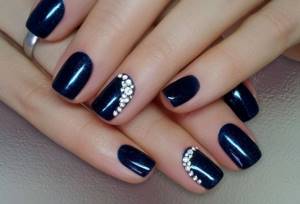
Lyubavin Alexey Vladimirovich: The main problem lies in sawing off the top glossy layer. Inexperienced craftsmen quite often saw through the required amount. As a result, the integrity of the nail plate is destroyed and becomes susceptible to various types of bacteria and infections. Which is fraught with inflammation and infection. And add to everything drying chemicals that deprive the nails of normal breathing, and ultraviolet rays.”
As you can see, there is harm from gel polish and this is an indisputable fact. But the most important thing is to follow all recommendations for applying such a product. And don’t forget to take breaks to saturate your nails with vitamins and strengthening elements. Gel polish will help make your hands well-groomed and neat, but a manicure will only look like this on healthy nails.
Sources
- https://journal.podrygka.ru/byuti-mif-vreden-li-gel-lak-dlya-nogtej/
- https://nails-mag.ru/zdorove/gel-lak-vred/
- https://gel-lak.online/vreden-li-gel-lak-dlya-nogtej/
- https://mimiledi.ru/krasota/manikyur/vreden-li-gel-lak-dlya-nogtey.html
- https://heaclub.ru/vreden-li-gel-lak-dlya-nogtej-dostoinstva-i-nedostatki-produkta-chem-vreden-gel-lak-dlya-zdorovya-organizma-i-samih-nogtej-sostav- i-protivopokazaniya-chem-eshhe-vreden-gel-lak-nepravilnyj-spil-i
- https://poleznii-site.ru/zdorove/polza-i-vred-manikyura-gel-laka-dlya-zdorovya-cheloveka.html
- https://asiateka.ru/vredit-li-sushka-dlya-laka-nogtyam/
[collapse]
Is gel polish harmful to health?
Gel polish may be harmful to health in some cases:
- When coating is done for obvious problems with nails. For example, they are thinned, pain is felt, there is a gray coating on the surface, or the color in some places has turned green or brown. This may indicate the development of a fungal disease or burn, which requires treatment, not design.
- When the coating is poorly dried, that is, it is polymerized on top, but closer to the nail it remains wet. This is another favorable factor for an infection called Pseudomonas - Pseudomonas. It makes the natural nail green.
- When there is an allergy. It may not appear immediately, but as the unwanted substance accumulates in the body. That is, not even from the first manicure, but after correction with the same means. The fingers begin to itch and hurt, the skin turns red and becomes wet.
- When there are detachments of the material, and the girl does not remove it for weeks. The narrow space between the nail and the coating is a favorable environment for bacteria. Dirt and sweat get in there and are difficult to clean out. The result is a change in the color and structure of the plate, indicating a degenerative process or infection.
- When the cuticle is not cleaned thoroughly enough, and varnish has flowed into it. This is also the cause of the inflammatory process, and then suppuration. At first a small wound forms, then it grows, and the pain intensifies. As a result, the nail may begin to grow already changed - lumpy and peeling.
- When the coating is cut off indoors without an exhaust hood and without a mask on the face. Small particles enter the respiratory tract and can cause asthma. Those who often have colds and are prone to allergies are especially at risk.
Is it possible to do shellac while pregnant?
- it is necessary to strictly adhere to the coating technology, without deviating from the existing rules of the procedure;
- pause after three or four applications of the cosmetic product. During the break, it is advisable to undergo a course of therapeutic coatings and paraffin therapy. If your nails become very peeling, you can carry out procedures with fruit acids. Homemade baths and hand masks will consolidate the results;
- Do not manicure on sick or peeling nails. This is especially true for plates affected by fungus. As we have already written, they need to be completely cured before the procedure;
- if the skin around the nail is too sensitive or cracked, it is prohibited to use decorative coatings until the damaged areas are restored;
- It is necessary to regularly rub medicinal oils into the cuticle area.
How often can you do gel polish, can you do it all the time?
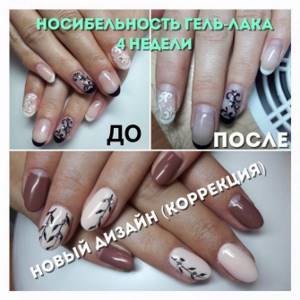
Gel polish can be done frequently, that is, every 2-3 weeks if the nails are growing rapidly and there are no problems with them. It’s worse if they have grown a lot, but the coating remains the same. This not only looks unsightly, but also harms your nails. The polymer bonds of the coating begin to disintegrate and release harmful substances, which penetrate through the plate.
In addition, worn-out coating is more difficult to remove. The remover will have to be kept on the nails longer, and when filing, there is a greater chance of damage to the plate. After all, the adhesion of the material may strengthen over time.
Doing gel polish all the time is harmful even with healthy and very strong nails. There are chances of missing the beginning of problems with them due to exposure to chemicals and lamps. After all, during correction, only the color coating is often removed, leaving the base. And you can’t evaluate the appearance of your nails.
And if the material is completely removed, this is also difficult, since the surfaces of the plates are treated with a buffer and wiped with a degreaser and primer before coating. And to understand whether everything is in order, you need to wait until at least part of the nails, untouched by tools and liquids, grow back. That is, take a break for at least 3-5 weeks. It’s better to extend it for 3.5 months, because it is during this period that the nails are completely renewed.
In addition, with constant and long-term wearing of gel polish, the plates become thinner, as they are buffed, dried with a dehydrator and degreaser, and the surface is loosened with a primer. To avoid critical thinning, it is better not to apply long-term coating for several weeks a year.
Contraindications for gel polish
Even expensive and high-quality gel polish has contraindications for use:
- allergies to it or other products used in manicure;
- dystrophic diseases of the nail plates (onycholysis, etc.);
- fungus of nails and skin of hands;
- damage to the plates and periungual space;
- burns in this area;
- hand skin infections;
- treatment with hormonal drugs (taking oral contraceptives to prevent pregnancy does not count);
- chemotherapy or the recovery period after it.
You may not want to wear gel polish if you have a lot of moles on your hands and have a hereditary predisposition to skin cancer. It is better to discuss this with your doctor. The procedure should be postponed if the temperature rises and on critical days.
Unfounded facts
Along with the popularity of gel polish, a large number of rumors about this product have appeared. Many facts are unfounded.
The product actually causes harm. But most often
during which the top of the nail comes off. If you follow the technology and use high-quality products, the plates will remain in their original healthy form.
The coating serves only as a “protective shell” for the plate. The product allows you to protect even weak nails from injury and help them grow to the desired length. But the coating does not provide a therapeutic effect. If there is already a fungus, it is better to cure it first and then apply the gel.
In fact, you need to be careful with your new manicure for the first two days. It is advisable to avoid contact with caustic chemicals and do not wet your nails in hot water. By following these rules, the material will remain durable for a long time. The coating does not require any other special care.
Do nails breathe under gel polish?
Nails under gel polish do not breathe, just as they do not do so without coating. The plates consist of keratinized cells; they do not have pores or a respiratory system. Their nutrition depends on the state of the deep germ layer, and not on the surface. Therefore, it is so important to handle the cuticle with care and not try to fill the flower garden as deep as possible under it. After all, there is a matrix responsible for the growth and structure of the nail.
The surface condition of the plates is more important for their protection and appearance. It protects deeper layers and skin from injury. Therefore, it is important to maintain nail thickness to a normal level. Otherwise, due to manicure, bruises and burns may appear under the plates.
What is wrong with gel polish on nails?
Gel polish on nails is afraid:
- abundance of moisture, when hands are often in water without gloves;
- mechanical impact, if you use your nails to scrape, for example, dirty dishes or plaster from the walls;
- household chemicals – detergents, solvents, hair dyes;
- sudden changes in temperature (baths, some salon procedures, etc.);
- abundance of sunlight, from which the color fades;
- filing of nails, which disrupts the integrity of the coating from their tips and spreads further.
If you don't know how to wear a long-term manicure, it won't last longer than a few days. The entire coating may not fall off, but noticeable defects will appear on it.
How long can you wear without harm?
In any case, there is some harm from gel polish, but much depends on the duration of contact between the nail plate and the coating. You can usually wear a manicure for no longer than two weeks. Under the influence of daylight or natural ultraviolet rays, the coating gradually becomes more dense.
It will be more difficult to remove when visiting the salon. The longer gel polish is left on the nails, the more damage it causes and the greater the risk of injury when removed.
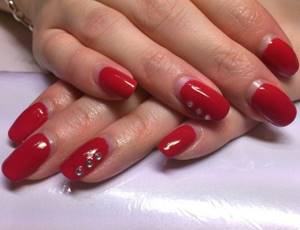
The best harmless gel nail polishes
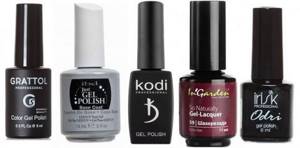
Gel nail polishes, which have already proven themselves to be as harmless as possible, are:
- Kodi is rubber-based and contains natural oils;
- IBD, which is easy to apply and remove, does not contain harmful components;
- Ingarden with natural resins and silicones in its composition;
- Irisk, which contains natural oils, has no allergens;
- OPI, known for its abundance of natural ingredients;
- IQ Beauty with calcium;
- Luxio is solvent- and formaldehyde-free, hypoallergenic;
- Grattol, which do not contain acrylic and methacrylic acids and other ingredients that provoke intolerance.
But even when using these funds, individual reactions must be taken into account. It is also important to buy original gel polishes, and not replicas or fakes.
Recommendations for minimizing the consequences
To prevent the beauty of a manicure from being detrimental to your nails and health in general, you should follow some rules:
- do not apply the coating if you have a disease or suspect it, but first go to the doctor;
- even with strong nails, take breaks from wearing gel polish to assess their condition;
- during this period, use recovery tools;
- use only high-quality removers, primers, gels, bases, tops and a suitable lamp;
- it is better to combine all the funds from one company so that there is no conflict between them;
- apply products in not too thick layers;
- dry the coating for the specified time, no more and no less;
- do not tolerate burning while drying in the lamp;
- be sure to use cuticle oils;
- do not peel off the peeling coating, since it also removes the top layer of the nail;
- Be sure to eat protein foods, vegetables and fruits, all this ensures healthy nail plates and skin.
Long-term manicure is no more harmful than using regular polishes. To implement it, it is important not only to choose a good flower garden, but also a base and top. If you experience discomfort, you should immediately remove the coating, and if your nails seem unhealthy, go to the doctor.
Expert advice
Manicure and pedicure experts share some recommendations that significantly reduce the possible harmful effects of shellac. And not only on the surface of the nails and skin, but also on the entire state of the body.
- It is prohibited to use varnish with a gel base for those who have cracks, fungus or any damage to the nail plate. It is also not recommended to apply gel polish to those whose nails are very flaking.
- You should take a course of medications or vitamins if your nails have a dull and faded appearance.
- It is advisable to enrich the cuticle with nourishing oils, because they contain quite a lot of vitamin components. And this helps nourish the nail itself.
- It is necessary to systematically cover your nails with a colorless nourishing varnish, which can be purchased at any pharmacy or specialty store. Take a break from gel polish at least once every six months.
- To ensure that wonderful and well-groomed nails are always neat and elegant, you should choose only a professional and certified nail technician. If you are practicing or planning to apply the gel yourself, then study each step.
- If you use dark colors, apply a thicker layer of base. This will prevent the plate from staining.
- Do not remove polish with acetone. Prolonged contact has a detrimental effect on nails.
- Be sure to pay due attention to the varnishes themselves. They must be of high quality and not have the harmful additives that we wrote about above.

We also offer you a list of harmless gel polishes
- The well-known brand Kodi contains natural oils that have a beneficial effect on our nails. But this company is loved by users for its rubber base, which allows air to pass through and allows them to breathe.
- Ibd varnishes also feature natural ingredients and a complete absence of harmful additives. Moreover, the opaque bottle also protects the contents from ultraviolet rays. Just keep in mind that this all concerns the original, and not the Chinese analogue.
- The Entily brand has already firmly established itself as a durable coating that reliably protects against chips. Moreover, it contains olive and argan oils. And they even additionally nourish the nails. By the way, some varnishes from this company also include natural mica, which more saturates the color and adds a pearlescent touch.
- Irisk varnishes are considered a hypoallergenic product. They do not contain harmful additives. But there are various oils for nourishing the nail, which even help with delamination. By the way, these varnishes also stand out for their quick-drying properties.
- Gels from InGarden can be safely used even for problematic nails that flake or often break. After all, natural resins, silicones and nutritional components will help take care of your nails.
- And it is worth highlighting the Axxium OPI brand, which contains natural substances. But most of all I liked it because there was no need to cut off the top layer of the plate. And this is another plus for strengthening nails.

